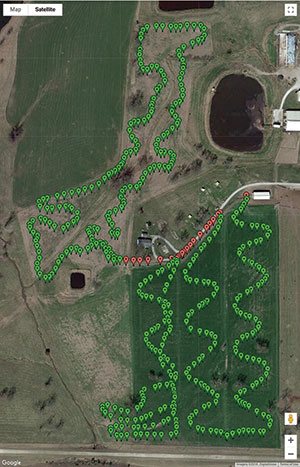Missouri forage app improves profits |
|
Waypoints along the traveled path are mapped in paddocks as data is collected. The output helps producers see how well they covered their farm. |
Geist is a strategic communication associate with the University of Missouri. Hamilton is an extension dairy specialist and Lock is a research specialist, both with the University of Missouri.  Waypoints along the traveled path are mapped in paddocks as data is collected. The output helps producers see how well they covered their farm. One of the newest technologies, PaddockTrac, helps producers make sound decisions on when to graze and when to fertilize pastures, according to Extension Dairy Specialist Stacey Hamilton. It also helps producers track forage inventory and decide where to graze cattle first, and then consider if there is extra forage to harvest for hay or silage. In 2006, a Grazing Wedge tool (grazingwedge.missouri.edu) was developed to help farmers with these decisions. To use the tool, farmers still had to walk over pastures, using rising plate meters, to measure forage yield. They manually entered data into the website every week. The Grazing Wedge website helped forage managers for years but required a lot of time walking across pastures to take measurements and then manually enter the data on the website every week. “This process needed to be improved to reduce the labor needed to collect the necessary data,” said Ryan Lock, a research specialist at the University of Missouri. An improved approach Hamilton, Lock, and Missouri Extension Forage Specialist Rob Kallenbach made the process easier, more affordable, and less time consuming when they developed the PaddockTrac app. The automated tool uses ultrasonic sensors to measure forage yield in pastures. Sensors mounted on an all-terrain vehicle send data to the producer’s smartphone via Bluetooth. PaddockTrac stores both GPS location and forage height 10 times per second on the user’s smartphone. The phone uploads data to a GIS-based website and then an online tool accurately assigns the data to an individual paddock. Once completed, the producer can see their Grazing Wedge showing forage yield in each paddock, sorted from high to low. This allows producers to be proactive in their decision-making, said Hamilton. “Basically, the tools give a weekly forage inventory of your farm,” Hamilton explained. “Instead of knowing how many bales of hay you have stored in the barn and then subtracting bales as they are used, or adding bales, the tools tell you how much forage you have available for feed or harvest.” PaddockTrac also lets producers decide if their pregrazing forage mass is right for the desired postgrazing residual. “How long cows stay on a paddock; the amount of supplement needed, if any; nitrogen application; and the amount of forage available for haying or silage can be estimated through the use of these web-based tools,” Hamilton said. “As a result of proper measurement and monitoring, improvements in forage yield, enhanced nutritive value, improved longevity of stands, and better utilization of forage by grazing animals can be realized. This app allows adaptive management strategies in forage systems that mitigate overgrazing, degraded plant vigor, and soil loss.” The team’s first attempt to use ultrasonic sensor technology began in 2008. “The initial idea came from our need to measure hundreds of paddocks each week for Kallenbach’s grazing experiments,” said research specialist Danny England. England located sensors that fed data into a military-grade laptop computer mounted onto an all-terrain vehicle. It could withstand rugged travel over pastures. However, the cost of the military-grade laptop made this option too expensive for most farmers, Hamilton said, and drove the team to find another means that made the tools user-friendly and affordable for the average producer. Extension specialists in Missouri offer group and one-on-one training on how to use the grazing tools as part of an integrated system. User proven Fourth generation Monett, Mo., dairy farmer Mike Meier and his wife, Janan, know the value of incrementally putting new systems in place. They are beta testers for the PaddockTrac program. Working on this project and others has improved the Meier’s profits and herd health. It also has given them more time to spend with family. Meier is a believer in the PaddockTrac system that gives him better profits in the unstable dairy industry. Naysayers are “leaving money on the table,” he commented. He estimates that those not using technology can lose 5 to 7 pounds of milk per cow daily. Hamilton agreed. When farmers get cows to eat nutrient-filled grass, it means better gains, more milk, and healthier cows. Long-term benefits of the research give producers the incentive to try new ideas. “The biggest motive to stick with it is profit,” Meier said. Some people yearn for data-driven methods; others find them a burden. “It is very difficult to manage what you don’t know,” Meier explained. Hamilton said the key is to start slow and improve the operation each year. This article appeared in the April/May 2019 issue of Grower on page 42. Not a subscriber? Click to get the print magazine. |
